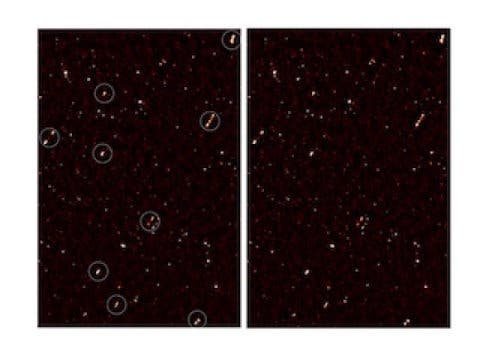Deep radio imaging from researchers working in South Africa have revealed that supermassive black holes in a region of the distant universe are all spinning out radio jets in the same direction. The results show, for the first time, an alignment of the jets of galaxies over a large volume of space. Astronomers believe this is due to primordial mass fluctuations in the early universe.

An image of the deep radio map covering the ELAIS-N1 region, with aligned galaxy jets. The image on the left has white circles around the aligned galaxies; the image on the right is without the circles.
Credit: Prof Russ Taylor
When things in outer space happen at the same time, there’s usually a reason for it – coincidences don’t really happen at this scale. So when Cape Town astronomers witnessed a similar ejection alignment, they knew something strange was up. Prof Andrew Russ Taylor and principal author of the new study notes:
“Since these black holes don’t know about each other, or have any way of exchanging information or influencing each other directly over such vast scales, this spin alignment must have occurred during the formation of the galaxies in the early universe,” he notes.
Prof Romeel Dave, SARChI Chair in Cosmology who wasn’t involved in the study but leads a team developing plans for universe simulations that could explore the growth of large-scale structure from a theoretical perspective, agrees:
“This is not obviously expected based on our current understanding of cosmology. It’s a bizarre finding.”
But this prospect raises another interesting question: supermassive black holes are the most massive objects in the known Universe, so if anything would align a number of them the same way, it had to be something major. The plausible explanation they found is a primordial mass fluctuation in the early universe that sent ripples across huge volumes. The only known possible options were cosmic magnetic fields, fields associated with exotic particles (axions) and cosmic strings.
The presence of alignments and preferred orientations can shed light on the orientation and evolution of the galaxies, especially early galaxies. This hasn’t been studied in great detail, as the finding wasn’t expected, as astronomers were actually kind of looking around to see what they can find – they weren’t expecting something of this magnitude. We’re starting to understand how the universe evolved – and this may help us understand where it goes from here.
“We’re beginning to understand how the large-scale structure of the universe came about, starting from the Big Bang and growing as a result of disturbances in the early universe, to what we have today,” says Prof Taylor, “and that helps us explore what the universe of tomorrow will be like.”
Journal Reference:
- A. R. Taylor, P. Jagannathan. Alignments of Radio Galaxies in Deep Radio Imaging of ELAIS N1. Monthly Notices of the Royal Astronomical Society, 2016









